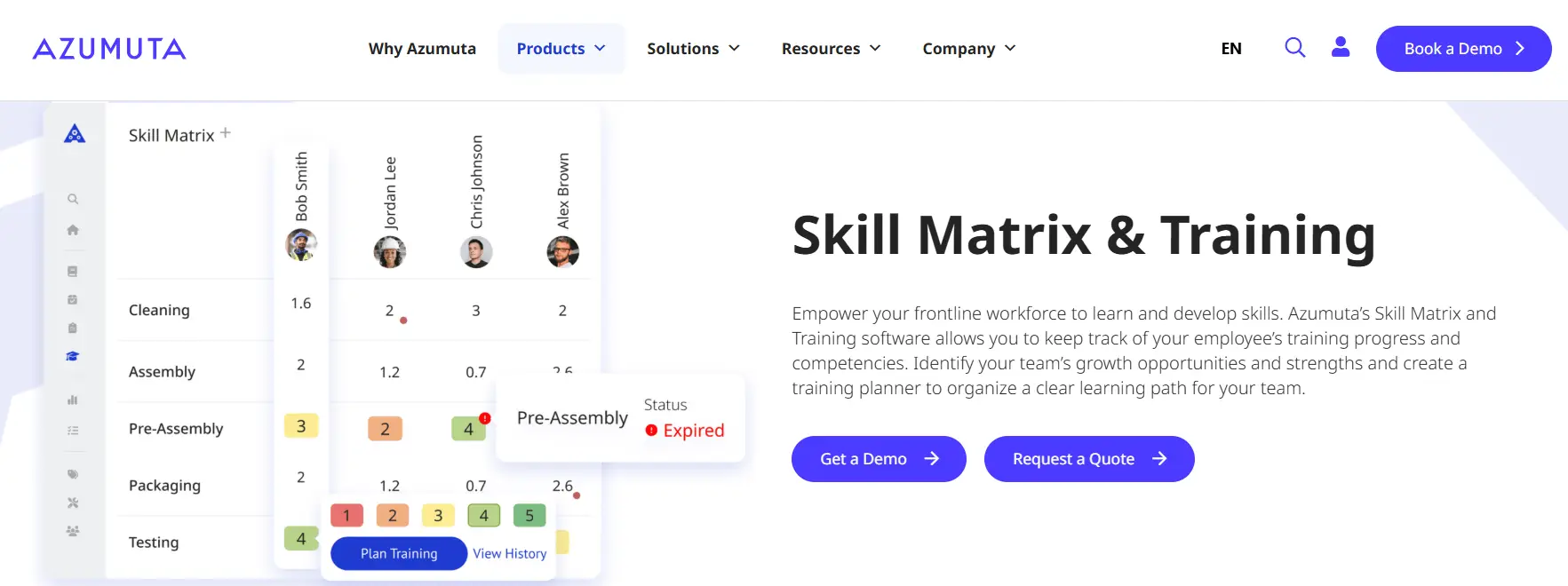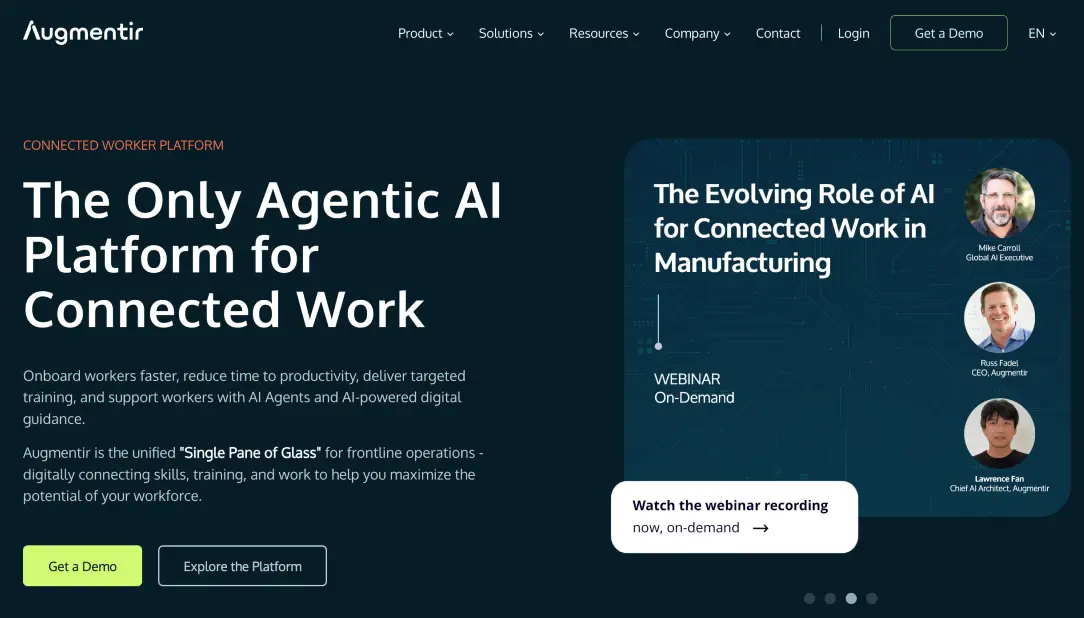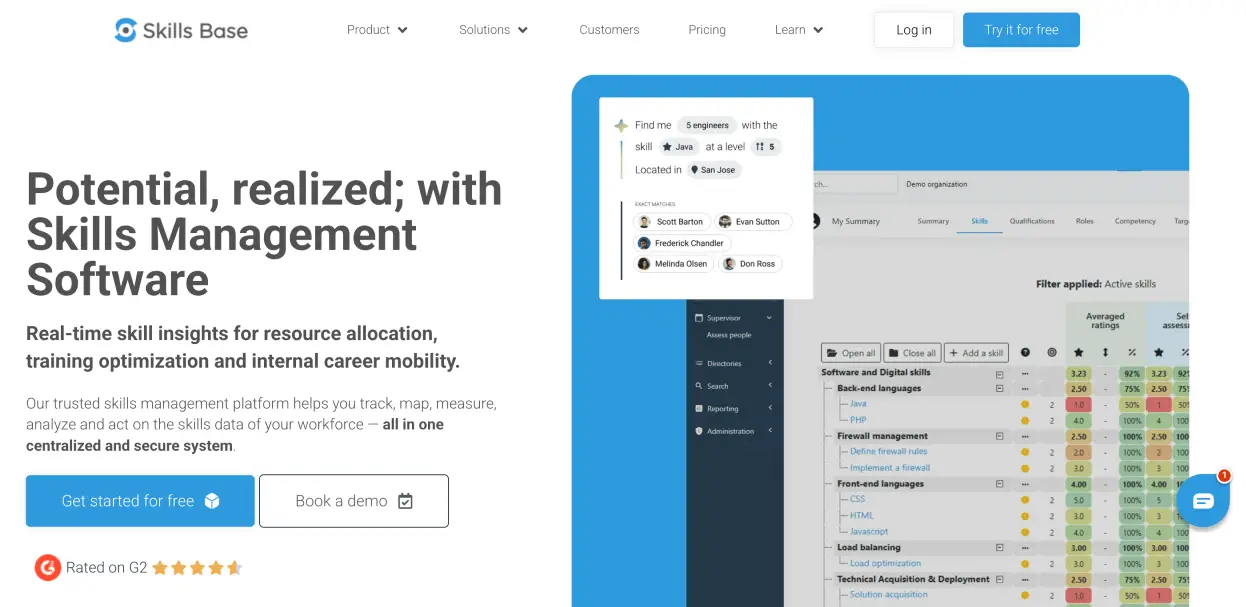Training matrix software is a handy tool for an efficient and organized method of tracking employee certifications, training, and skills. Such a tool lets companies visualize the current capabilities of their workforce, ensuring employees are adequately equipped to meet regulatory requirements.
This software streamlines workforce management by centralizing training data, helping companies discover skill gaps and track progress. Additionally, it also assists with the planning of future training initiatives.
What is Training Matrix Software?
Training Matrix Software is a digital tool that helps organizations map, track, and manage employee training, skills, and certifications efficiently. It provides a centralized view of who has completed required training, who needs upskilling, and where critical skill or compliance gaps exist.
Unlike manual spreadsheets, training matrix software automates tracking and reporting, making it easier for HR, L&D, and compliance teams to:
- Link employee roles to specific training requirements.
- Monitor training completion rates and certification renewals.
- Identify skill gaps and plan targeted learning programs.
- Maintain compliance with industry or regulatory standards.
- Visualize training data through dashboards and reports for quick decision-making.
In essence, Training Matrix Software ensures that workforce development efforts are structured, measurable, and aligned with organizational goals.
Key Features to Look For in training matrix software
- Role-to-skill mapping: ability to define roles, assign required skills/training for each role, and keep this matrix dynamic.
- Centralised skills inventory: track current workforce skills, certifications, training status and proficiency levels in one place.
- Skill gap analysis: automatically compare existing skills/qualifications to role requirements to highlight where training or development is needed.
- Skills benchmarking: measure skills/proficiency levels across employees, teams or against industry/organisational standards.
- Real-time dashboards & analytics: visualise skills coverage, training completions, gaps, readiness by department/location.
- Integration with HR tech stack: connect with LMS, HRIS, ATS and other systems so training/skills data flows across platforms.
- Scalable and future-ready skills taxonomy: support large skills libraries, allow addition of new roles/skills, map adjacent or emerging skills.
- Automated alerts & workflows: reminders for expiring certifications, upcoming training requirements, role changes affecting matrix needs.
- Internal mobility & talent redeployment: use skills/role data to match employees to new roles or projects based on matrix coverage.
- Robust security, access controls & audit trails: ensure data integrity, secure access by role, maintain compliance.
Top 12 Best Training Matrix Software in 2025
1. iMocha
.webp)
iMocha is a comprehensive AI-powered Skills Intelligence Platform that helps organizations create a robust Training Matrix for effective workforce development.
This enables companies to stay ahead of the competition by adapting rapidly to ongoing business evolution.
key Features:
- Skills Inventory: iMocha provides organizations with deep insight into the workers' skills. It helps companies determine future needs for skills development, recruit the appropriate candidates, and redeploy employees to critical projects for optimal use of resources.
- Skills Matching: The platform validates both core and secondary skills, aligning them with existing business requirements. This way, a well-equipped workforce is geared to the tasks ahead, significantly contributing to organizational success.
- Skills Benchmarking: iMocha ensures appropriate benchmarking of primary, secondary, and soft skills. This reveals internal skills gaps and helps organizations align their talent strategies, according to specific needs.
- Skill-gap Analysis: iMocha deploys a comprehensive skill-gap analysis of present skills and compares it with post-training expectations. All this allows a company to design effective training initiatives while bridging the gap.
Pros:
- Extensive skills library with 3,000+ assessments
- AI-driven skills inventory, benchmarking, and gap analysis
- Seamless integration with ATS and HR systems
- Advanced proctoring and fraud detection tools
- Customizable training insights for targeted upskilling
Cons:
- No psychometric assessments
- Feature-heavy for small teams with basic needs
G2 Rating: 4.5/5 (269 reviews)
Pricing: Checkout iMocha's pricing here
2. Cloud Assess

Cloud Assess is an advanced employee training platform that improves the training process within organizations by providing digital solutions for efficient training. It provides robust tools for tracking, delivering, and managing training programs to help employees gain relevant skills in compliance with industry standards.
key Features:
- Employee Training Efficiency: Cloud Assess enables organizations to deliver permanent skills, keep their workforce away from risk factors, and improve worker safety through easy delivery and validation of skills.
- Skill & Compliance Gap Visualization: It helps visualize gaps in skills and compliance conveniently to make tracking and developing employee training easier.
- Skills Development and Compliance: The platform helps verify long-term skills, avoid fines, demonstrate compliance, maintain customer service quality, streamline the process of onboarding, prevent workplace incidents, and enhance work quality.
Pros:
- Strong compliance support with digital skill validation
- Visualizes skills and compliance gaps clearly
- Mobile-friendly platform for on-the-go learning
- Effective onboarding and risk-reduction features
Cons:
- Lacks support for complex enterprise-level workflows
G2 Rating: 5.0/5 (2 reviews)
3. BIS Safety Software

BIS Safety Software offers a robust training matrix software that streamlines employee development by tracking training, certifications, and competencies in one place. This tool is purpose-built to manage employee progress and ensure alignment with organizational learning and compliance goals.
key Features:
- Automated Training Assignments: Companies can automatically assign employee training with this software. The digital forms and training plans are controlled according to a worker's role and location and updated dynamically according to the change in roles or locations.
- Customizable Training Requirements: It assigns requirements for training related to location, company roles, individuals, regions, cities, departments or divisions to help people customize and select the proper course accordingly.
- Custom Certification Programs: The platform offers the ability to establish an automatic certification program that an organization provides. It also helps with automatic advancements to the next level once all the requirements are satisfied.
Pros:
- Automates training assignments based on roles and locations
- Supports custom certifications and advancement rules
- Scales well for multi-location organizations
- Efficiently tracks compliance across departments
Cons:
- Dated user interface
- Focused primarily on safety and compliance sectors
G2 Rating: 4.8/5 (51 reviews)
4. Kaizen Software Solutions

Kaizen Software offers a training matrix software that enables organizations to keep track of all employees' training and ensure it retains compliance. The software helps with qualifications, certifications, and development because of the structural tools that make it easy to organize training activities so that all staff members attain competency.
key Features:
- Training Matrix Creation: This tool helps develop a training matrix based on which training topics various employees require and by when.
- Reports for Tracking: The software helps generate reports to determine what requirements are due and what will come up soon for training based on the defined period. Users get to see the training and schedule accordingly.
- Automatic Updates: Any changes in group membership or assumption of new job roles automatically update requirements for training. This feature ensures that the training needs change dynamically with the employee's role.
Pros:
- Straightforward training matrix creation
- Auto-updates training needs based on role changes
- Generates training reports for tracking compliance timelines
Cons:
- Minimal integration options
- Basic user interface with limited feature depth
G2 Rating: 4.0/5 (1 review)
5. AG5

AG5 offers a cloud-based training matrix platform that enables companies to manage, track, and visualize the skills and competencies of their workforce in a streamlined way. The platform repeatedly highlights the importance of a clear skills matrix to help organizations better manage skills, certifications, and training needs.
key Features:
- Skills Visualization: The software empowers organizations to visualize gaps in skills between teams and map their requirements for training without relying on complicated spreadsheets.
- Skills Data and Training Integration: It combines skills data and requirements into an updated training matrix that eliminates the need to use color-coding skills in multiple tabs to plan job executions.
- User-Friendly Interface: AG5 provides an intuitive interface that can manage team skill and training requirements to keep the data updated.
Pros:
- Clear visual skill matrix eliminates spreadsheet reliance
- Real-time certification and competency tracking
- Intuitive user interface
- Combines training and skills data for accurate planning
Cons:
- Requires initial setup time to map roles and skills
- Limited customization for highly specialized roles
G2 Rating: 4.7/5 (16 reviews)
6. HandsHQ

HandsHQ is a training matrix system that helps organizations manage their employee training and certifications efficiently. The system ensures that all staff qualifications are updated and enables the organization to plan and track training across teams to ensure compliance and development.
key Features:
- Skill Gaps Identification: The software identifies skill gaps by going through all the training records in one place, which ultimately helps better workforce management.
- Centralized Training Records: All records, evidence, and training needs analysis are stored in one place, making it easier and simpler to access and manage that information.
- Training Expiry Date Tracking: It tracks training renewal dates to foresee and prepare in advance for refreshed courses rather than responding to situations.
Pros:
- Centralized training records and documents
- Highlights skill gaps across teams
- Tracks training expiry dates for proactive renewals
Cons:
- Lacks scalability for large enterprise use
G2 Rating: NA
7. Azumuta

Azumuta is a skills matrix and training matrix software designed for manufacturing environments. It helps organizations track employee training, visualize skill coverage, and support competency development on the shop floor. With real-time dashboards and integrated work instructions, teams can easily monitor progress and stay production-ready.
key Features:
- Real-time Skills Matrix: Managers can view and update employee competencies live, making it easier to assess training coverage across roles and production lines.
- Integrated Work Instructions: Azumuta connects training plans with real-time digital work instructions, helping employees learn directly within their workflow.
- Training Needs Detection: The platform automatically flags skill gaps based on role requirements and team coverage, supporting targeted upskilling efforts.
- Progress Dashboards: Interactive dashboards give clear visibility into team readiness, completed trainings, and pending certifications.
- Audit-Ready Reports: Built-in reporting tools allow quick access to training records, which simplifies compliance audits and performance reviews.
Pros:
- Real-time skill matrix tailored to job roles and shop floor needs
- Interactive dashboards for monitoring training and skill progress
- Easy integration with digital work instructions and audits
- Designed specifically for manufacturing environments
Cons:
- Not ideal for non-industrial or service-based organizations
- Limited reviews from broader enterprise markets
G2 Rating: 4.8/5 (14 reviews)
8. Vision

Vision is a comprehensive training matrix software solution offered by vision management systems. It helps businesses of all sizes monitor staff training and track compliance. The platform ensures employees meet all required training standards while supporting skill development across teams.
key Features:
- Categorized Training: With this feature, organizations can see a crystal-clear view of their training coverage spread across different categories, offering an overall snapshot of the training landscape.
- Real-time Training Status: Companies can easily know whether the training is overdue or in-date for their group using this software.
- Color-coded Dashboard: An intuitive dashboard offers a clear indication of training status using visual cues to place a quick assessment of the training landscape.
Pros:
- Real-time training status with visual cues
- Categorized training view for easy management
- Color-coded dashboard simplifies monitoring
Cons:
- Dated interface design
G2 Rating: NA
9. WorkAware

WorkAware is a training matrix tool that manages the course, certification and orientation of employees from different industries. It ensures compliance, strengthens safety, and guarantees workforce competency through the training needs' central report and management system.
key Features:
- Training Matrix: The software's capabilities apply to any organization since it gives the potential of support by safety and operation that manages all other industries.
- Training and Certification Tracking: Companies can track internal and third-party training and certifications. This establishes the record of internal training and certifications of a company as well as those third-party accounts and permits evaluation for ongoing training without direct supervision.
- Skill Gap Analysis: It helps decide the competency level team members lack. This helps bridge the difference between the level of knowledge required and the one achieved so far.
Pros:
- Supports training matrix needs across various industries
- Tracks internal and third-party certifications
- Delivers clear skill gap analysis for planning
Cons:
- Primarily built for safety-focused industries
G2 Rating: NA
Check out our list of top 11 skills matrix software that enhances training matrices by tracking employee skills and aligning them with training programs.
10. Poka

The Poka Skills Matrix Management is a digital tool designed to optimize workforce skills management in manufacturing environments. It allows companies to track, manage, and develop employee skills through an intuitive interface, ensuring that the workforce stays competent and aligned with operational needs.
key Features:
- Skills Matrix and Management Capabilities: It offers a skills matrix and management capabilities. It enables workers and team leads to oversee and stay updated with role-specific and factory training, maximizing skill versatility and coverage.
- Custom Training Programs: The platform helps create and assign training programs based on job location and role, tailoring training to specific organizational requirements.
- Individual & Team Skills Tracking: The software allows companies to track training completion with an at-a-glance view of skills coverage and statuses for individual employees and teams.
Pros:
- Designed for manufacturing with robust skills tracking
- Visual team and individual progress views
- Enables role- and location-specific training assignments
Cons:
- Limited suitability outside of industrial settings
- Onboarding required for advanced features
G2 Rating: 4.7/5 (165 reviews)
11. Augmentir

Augmentir is an AI-powered skills management and training matrix software designed primarily for frontline and industrial workforces. It enables organizations to visualize, manage, and optimize training, skill gaps, onboarding, and deployment.
Key Features:
- Skills Matrix & Gap Visualization: Maps roles, required skills, and training status across individuals and teams to identify gaps in competencies or certifications.
- Onboarding, Compliance & Team Readiness: Tracks workforce readiness by role or department and ensures compliance with regulations like OSHA and ISO.
- Dynamic Training & Work Assignment: Digitizes training, assessments, and endorsements while using skill data to intelligently assign work to appropriately skilled employees.
- AI-Driven Insights & Continuous Learning: Provides analytics on training effectiveness, highlights impactful learning content, and connects training with on-the-job performance.
Pros:
- Strong fit for industrial and operational environments
- Integrates training data with workflows for actionable insights
- Enhances workforce safety and productivity
Cons:
- Primarily suited for manufacturing or operations
- Initial setup required for skill and role mapping
G2 Rating: 4.4/5 (24 reviews)
12. Skills Base

Skills Base is a cloud-based skills matrix and competency management software that helps organizations visualize workforce skills, identify gaps, and plan employee development more effectively. It simplifies skills tracking and reporting while reducing reliance on manual spreadsheets.
Key Features:
- Centralized Skills Matrix & Inventory: Captures and displays employee skills data across departments for complete visibility of team capabilities.
- Skill Gap Identification & Development Planning: Detects individual and organizational skill gaps and creates personalized development plans.
- Reporting & Integration: Offers dashboards for real-time insights and API integration with HR or learning systems to streamline training management.
- Flexible Access & Scalability: Includes a free version for small teams and scalable paid tiers for enterprise-level usage.
Pros:
- Simple setup and intuitive interface
- Ideal for small to medium-sized organizations
- Supports integrations with other HR and learning tools
Cons:
- Limited built-in training delivery capabilities
- Reporting features may require customization for large enterprises
G2 Rating: 4.5/5 (27 reviews)
Learn how to create a skills matrix to map employee strengths, identify gaps, and address training needs effectively.
Conclusion
Most of the Training Matrix tools above provide core tools for tracking and managing employee training, ensuring compliance, and supporting organizational skill development.
However, iMocha’s AI-powered Skills Intelligence Platform combines skills inventory, skill-gap analysis, and personalized upskilling recommendations. Its comprehensive features go beyond training metrics to deliver real-time insights, helping organizations align their workforce with business goals.
FAQs
1. What are the benefits of using training matrix software?
Training matrix software provides clear visibility into workforce skills and training progress. It streamlines compliance tracking with automated updates and reminders. The tool also supports data-driven decisions by highlighting skill gaps and reducing manual administrative effort.
2. What is the difference between a skills matrix and a training matrix?
A Skills Matrix shows employees' skills and capabilities, and a Training Matrix keeps track of training needs, progress, and completed courses. The Skills Matrix focuses on capabilities, while the Training Matrix focuses on learning development.
3. How do you create a training matrix?
A training matrix is created by setting major training areas and mapping them against roles, tracking employee progress, and regularly updating. It can also be done with the help of software, which also helps smoothen tracking and certifications/compliance and skill development gaps.


.avif)
.webp)

.webp)


